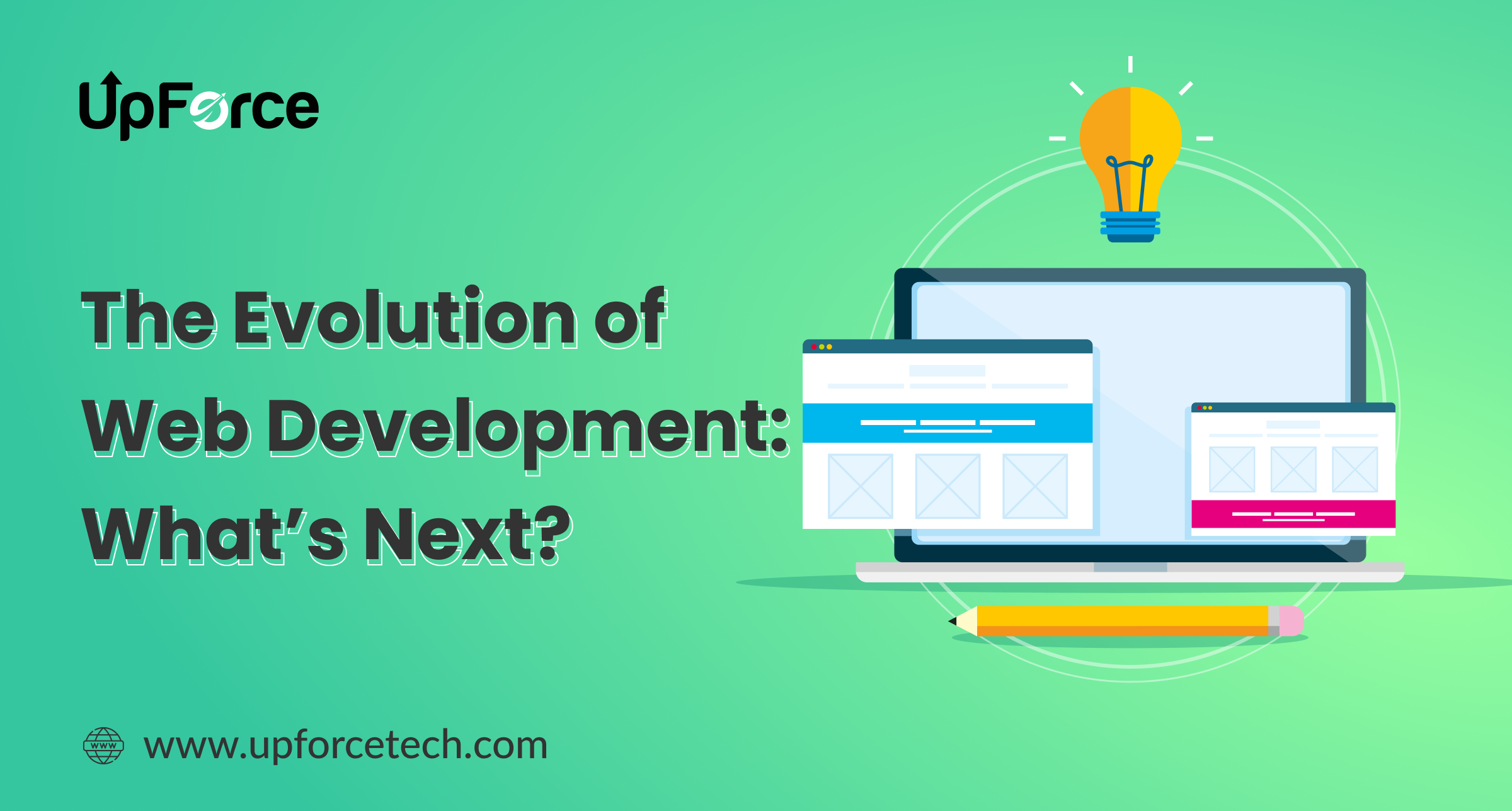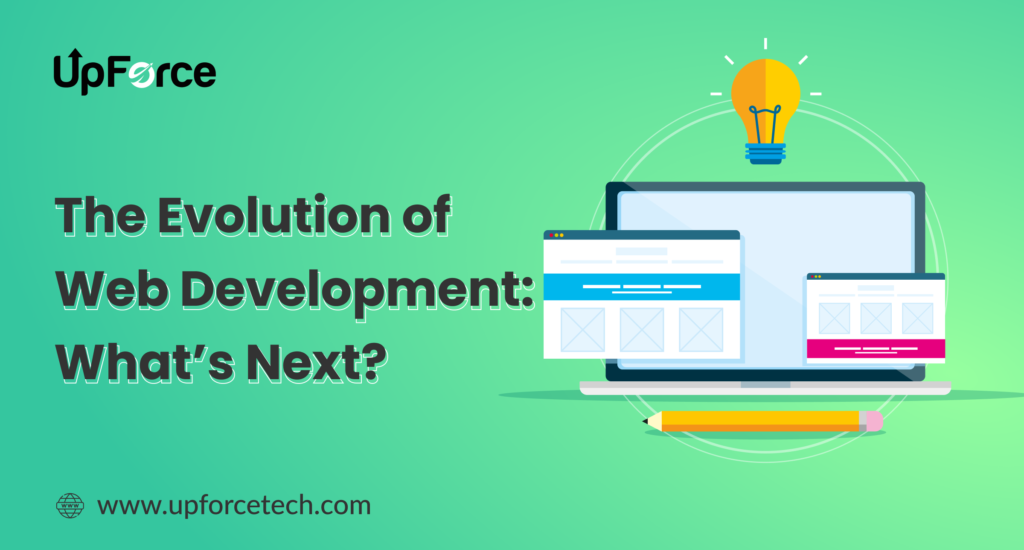The Evolution of Web Development: What’s Next?
Table of Contents
The Evolution of Web Development: What’s Next?
Web development has come a long way—from static HTML pages in the 1990s to dynamic, AI-driven, and immersive web experiences in 2025. With rapid advancements in technology, the web is becoming faster, more interactive, and smarter. But what does the future hold for web development?
In this blog, we’ll explore the evolution of web development, how it has changed over the years, and what exciting trends will shape its future.

The Evolution of Web Development: A Brief Timeline
1. The Static Web (1990s – Early 2000s)
- Websites were simple, consisting of HTML, CSS, and basic JavaScript.
- Pages were static, meaning they didn’t change based on user interactions.
- Navigation was straightforward but limited in design.
2. The Rise of Dynamic Websites (2000s – 2010s)
- JavaScript frameworks like jQuery made websites more interactive.
- PHP, ASP.NET, and Python became popular for server-side development.
- The rise of CMS platforms like WordPress allowed businesses to manage content easily.
3. The Mobile-First Revolution (2010s – Present)
- The shift towards mobile-responsive design became essential.
- Front-end frameworks like React, Angular, and Vue.js revolutionized UI development.
- Progressive Web Apps (PWAs) provided a hybrid between web and mobile apps.
4. AI-Powered and Immersive Web (2020s – Future)
- AI-driven chatbots, personalized experiences, and voice search optimization.
- The integration of AR, VR, and the Metaverse for more immersive web experiences.
- Blockchain and Web3 technologies are reshaping how users interact online.
What’s Next for Web Development?
1. AI-Powered Websites
AI is transforming web development, making it faster, smarter, and more user-centric.
🔹 AI-generated content and design.
🔹 Voice assistants and AI chatbots for seamless customer interactions.
🔹 Personalized user experiences based on browsing behavior.
📖 Read More: How AI is Transforming Web Development
2. No-Code & Low-Code Development
Developing websites no longer requires deep coding knowledge.
🔹 Drag-and-drop builders like Webflow, Wix, and Bubble.
🔹 Low-code platforms for rapid web application development.
🔹 Faster prototyping and deployment with minimal coding.
3. Web3 and Decentralized Applications (DApps)
The shift towards Web3 is making web experiences decentralized and blockchain-powered.
🔹 No single entity controls user data.
🔹 Smart contracts enable direct user interactions without intermediaries.
🔹 Crypto payments and digital identity verification are becoming common.
4. Progressive Web Apps (PWAs) and Super Apps
PWAs continue to rise, bridging the gap between mobile and web experiences.
🔹 Faster load times and offline functionality.
🔹 Push notifications like mobile apps.
🔹 Cross-device compatibility.
📖 Learn More: Why Progressive Web Apps are the Future
5. Motion UI and Microinteractions
Modern web design is shifting toward fluid animations and microinteractions.
🔹 Subtle hover effects, transitions, and scrolling animations enhance UX.
🔹 Web pages feel more engaging and interactive.
🔹 Motion UI makes websites visually appealing without slowing performance.
6. Cybersecurity-First Web Development
With cyber threats increasing, security is a top priority for developers.
🔹 Zero-trust security models for safer authentication.
🔹 Biometric authentication replacing traditional passwords.
🔹 AI-driven threat detection and prevention systems.
📖 Related Article: How Cybersecurity is Changing Web Development
7. The Metaverse and 3D Web Experiences
The future of the web is immersive, 3D-driven, and interactive.
🔹 AR/VR websites for better customer engagement.
🔹 Virtual showrooms and 3D product experiences for eCommerce.
🔹 AI avatars and digital twins for virtual assistance.
Conclusion
The future of web development is exciting, dynamic, and user-driven. As AI, Web3, and immersive technologies continue to shape the digital landscape, businesses and developers must stay ahead of the curve to deliver the best experiences.
Are you ready for the next era of web development?
Stay innovative, stay adaptable!
Are you looking to Grow your business with skilled developers? Hire a contract developer today to bring fresh ideas and expertise to your team. Learn how UpforceTech can help!
Sign up for the free Newsletter
The web is not a static entity; it evolves every day. The key to success is adaptability and innovation.
UpforceTech
FAQs
AI-powered websites, Web3, and immersive 3D web experiences will shape the future of web development.
AI will automate repetitive tasks but won’t replace creative problem-solving and user experience design.
JavaScript, Python, Rust, and Solidity (for blockchain development) are among the top choices.
Web3 will decentralize the internet, enabling blockchain-powered applications and improved user data control.
No-code and low-code tools will simplify development, but complex applications will still require coding expertise.
PWAs offer fast performance, offline functionality, and a mobile-app-like experience without needing installation.
By adopting the latest technologies, prioritizing cybersecurity, and focusing on UX design, businesses can stay ahead.
Yes, as cyber threats rise, developers must focus on secure coding, zero-trust security, and AI-powered protection.

